
In rock climbing, mountaineering, and other climbing disciplines, climbers give a grade to a climbing route or boulder problem, intended to describe concisely the difficulty and danger of climbing it. Different types of climbing each have their own grading systems, and many nationalities developed their own, distinctive grading systems.

Glossary of climbing terms relates to rock climbing, mountaineering, and to ice climbing.

Action Directe is a short 15-metre (49 ft) sport climb at the limestone Waldkopf crag in Frankenjura, Germany. When it was first climbed by German climber Wolfgang Güllich in 1991, it became the first climb in the world to have a consensus 9a (5.14d) grade. It is considered an important and historic route in rock climbing history, and one of the most attempted climbs at its grade, where it is considered the "benchmark" for 9a. The training techniques Güllich used to prepare for the unique physical demands of Action Directe also revolutionized climbing and what could be achieved.

Sport climbing is a type of free climbing in rock climbing where the lead climber clips into pre-drilled permanent bolts for their protection while ascending a route. Sport climbing differs from the riskier traditional climbing where the lead climber has to insert temporary protection equipment while ascending.

Chris Omprakash Sharma is an American rock climber who is considered one of the greatest and most influential climbers in the history of the sport. He dominated sport climbing for the decade after his 2001 ascent of Realization/Biographie, the world's first-ever redpoint of a consensus 9a+ (5.15a) graded route, and ushered in what was called a "technical evolution" in the sport. Sharma carried the mantle of "world's strongest sport climber" from Wolfgang Gullich, and passed it to Adam Ondra.

David Ethan Graham is an American professional rock climber. Professing to enjoy bouldering the most, he is one of the elite sport climbers and boulderers of his generation. Graham repeats classic routes or boulder problems as well as performing cutting-edge first ascents. He is known for climbing in 2005 an 8C (V15) graded boulder problem called The Story of Two Worlds, in Cresciano, Switzerland). He is also known for his stance against grade inflation and for his strong anti-chipping ethic. He writes an ongoing blog for the website of Climbing Magazine.
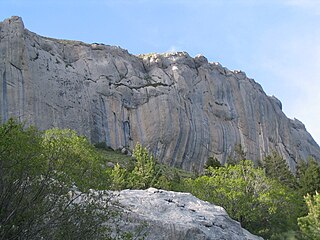
Realization, also called Biographie, is a circa 35-metre (115 ft) sport climbing route on a limestone cliff on the southern face of Céüse mountain, near Gap and Sigoyer, in France. After it was first climbed in 2001 by American climber Chris Sharma, it became the first rock climb in the world to have a consensus grade of 9a+ (5.15a). It is considered an historic and important route in rock climbing, and one of the most attempted climbs at its grade.
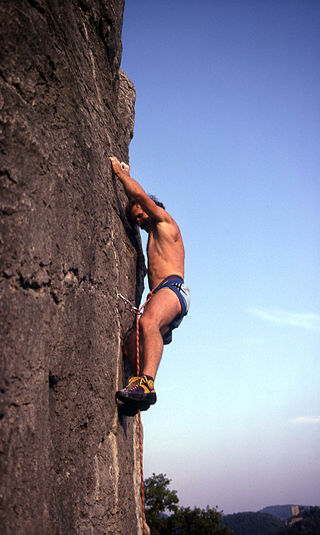
In rock climbing, redpointing means to free-climb a route from the ground to the top while lead climbing, after having practiced the route or after having failed first attempt. Climbers will try to redpoint a route after having failed to onsight it, or flash it. The first successful redpoint of a route, in the absence of any prior onsight or flash, is recorded as the first free ascent (FFA) of that route.

Deep-water soloing (DWS), also known as psicobloc, is a form of free solo climbing where any fall should result in the climber entering deep water below the route. DWS is therefore considered safer than normal free solo climbing, however, DWS brings a number of unique additional risks including trauma from uncontrolled high-speed water entry, injury from hitting hazards above and below the water while falling, and drowning in rough or tidal seas, and is thus considered riskier than normal bouldering.

La Rambla is a 41-metre (135 ft) sport climb at the limestone El Pati crag in Siurana, Catalonia in Spain. Originally bolted and climbed by Alexander Huber in 1994 as a 35-metre (115 ft) route, the bolting was later extended by Dani Andrada to a 41-metre (135 ft) route, which was eventually climbed by Ramón Julián Puigblanque in 2003. While there has been debate about La Rambla's grade, there is now consensus that it meets the 9a+ (5.15a) threshold. It is an important and historic route in climbing, and is part of the coveted "9a+ trilogy" with Realization and Papichulo.

The Wheel of Life is a 21-metre (69 ft) long sandstone bouldering route on the roof of the Hollow Mountain Cave in the Grampians of Australia. When first solved, it was graded at 8C+ (V16), one of the world's first-ever boulder routes at that grade. With subsequent repeats, it was graded at 8C (V15), and some consider it to really be a sport climbing traverse route, at the sport grade of 9a (5.14d).
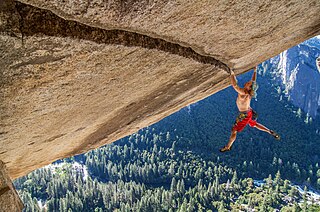
Separate Reality is a 66-foot (20 m) traditional climbing route in Yosemite National Park in California. The route is known for its exposed and dramatic crux that consists of a 20-foot (6.1 m) long crack in its horizontal roof. When it was first free-climbed by Ron Kauk in 1978, it was one of the first climbs in the world to have a grade of 7a+ (5.12a). In 1986, German climber Wolfgang Güllich free soloed the route, and the photographs by Austrian Heinz Zak become iconic in rock climbing history.

Mixed climbing is a climbing discipline used on routes that do have not enough ice to be pure ice climbs, but are also not dry enough to be pure rock climbs. To ascend the route, the mixed climber uses ice climbing tools, but to protect the route, they use traditional or sport rock climbing tools. Mixed-climbing can vary from routes with deep layers of ice and some exposed rock sections to routes that have no deep layers of ice, but where the rock is still covered in ice and/or snow.

Sasha DiGiulian is a professional rock climber. She won the gold medal at the 2011 International Federation of Sport Climbing World Championships in Arco, Italy, for Female Overall, placed Silver in Bouldering and Bronze in Duel. Sasha won multi-year PanAmerican championships and is a three-time US National Champion. She has climbed over 30 First Female Ascents as well as over a dozen significant First Ascents, including "Rolihlahla" in South Africa, a Big Wall in Brazil in 2016 and The Misty Wall in Yosemite in 2017. In 2011 she redpointed multiple 5.14c (8c+), onsighted two of 5.14a (8b+) and four of 5.13d (8b). In 2013 she was the first American woman to redpoint Era Vella 5.14d (9a), and established the First Female Ascent of Alpine Big Wall route, Bellavista, 5.14b (8c). In 2015, she became the first woman to free climb Magic Mushroom (7c+), one of the most difficult routes on the north face of the Eiger. In 2017 she did the first female ascent of Big Wall in Madagascar, Mora Mora (5.14b/8c), climbing it with Edu Marin in what was also the second free ascent of Mora Mora.
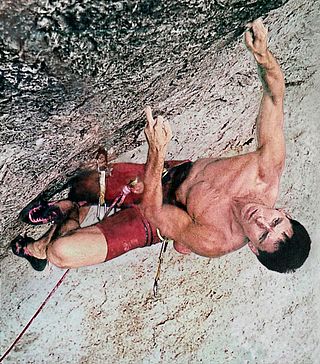
A crux in climbing, mountaineering and high mountain touring is the most difficult section of a route, or the place where the greatest danger exists. In sport climbing and bouldering, the most technically challenging point in the climb is also called the crux section. In describing a climbing route using a topo, cruces are usually shown with a key symbol.
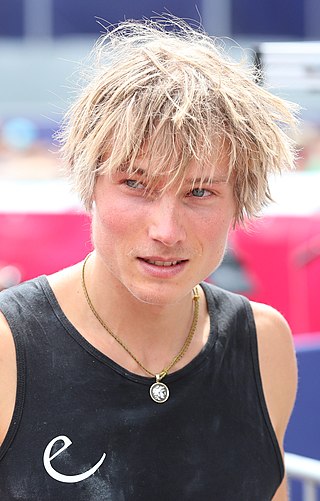
Alexander Megos is a German rock climber specializing in sport climbing, bouldering and competition climbing. In 2013, he became the first-ever climber to onsight a 9a (5.14d) graded route. He has made the first free ascent (FFA) of some of the hardest sport climbing routes in the world, including two 9b+ (5.15c) routes, three 9b (5.15b) routes, and several boulders with a boulder 8C (V15) rating.

Silence, is a 45-metre (148 ft) overhanging sport climbing route in the granite Hanshelleren Cave, in Flatanger, Norway. When Czech climber Adam Ondra made the first free ascent on 3 September 2017, it became the first rock climb in the world to have a proposed climbing grade of 9c (5.15d), and it is an important route in rock climbing history. To complete the route, Ondra undertook specialist physical and mental training to overcome its severely overhanging terrain.

Hubble is a short 10-metre (33 ft) bolted sport climb at the limestone Raven Tor crag in Dovedale, in the Peak District in Derbyshire, England. When Hubble was first redpointed by English climber Ben Moon on 14 June 1990, it became the first-ever climb in the world to have a consensus climbing grade of 8c+ (5.14c); and the highest grade in the English system at E9 7b.

Bibliographie is a circa 35-metre (115 ft) sport climbing route on a limestone cliff on the southern face of Céüse mountain, near Gap and Sigoyer, in France. The route was bolted in 2009 by Ethan Pringle, and was first ascended by Alexander Megos on 5 August 2020. Megos initially graded the route as 9c (5.15d), the highest difficulty at that time. The route was repeated on 24 August 2021 by Stefano Ghisolfi, who graded the route as 9b+ (5.15c), which has become the consensus grade for Bibliographie, making it only the fifth-ever climb in history at a grade of 9b+.

Dreamtime is a 10-metre (33 ft) long gneiss bouldering route in a forest in Cresciano, Switzerland. When first solved in October 2000 by Swiss bouldering pioneer Fred Nicole, it was graded at 8C (V15), making it the world's first-ever boulder route at that grade. With subsequent repeat ascents, it was regraded to 8B+ (V14), but after the breaking of a key hold in 2009, its grade is now considered closer to 8C (V15). Dreamtime is the most notable bouldering route in climbing history along with Midnight Lightning, and is renowned for both its beauty and its challenge.



















